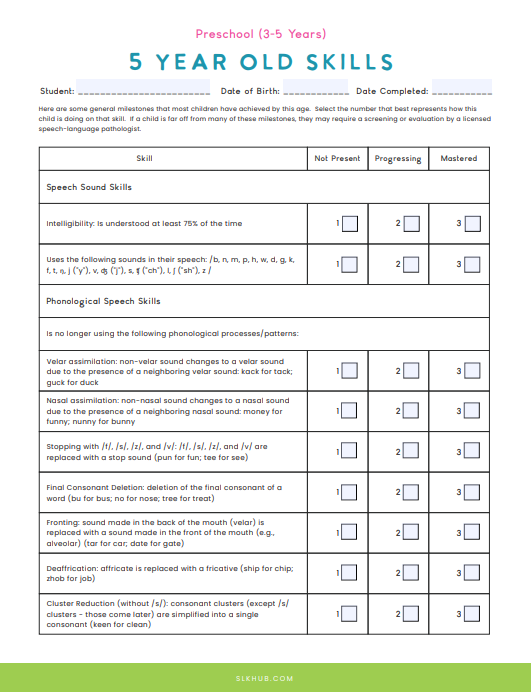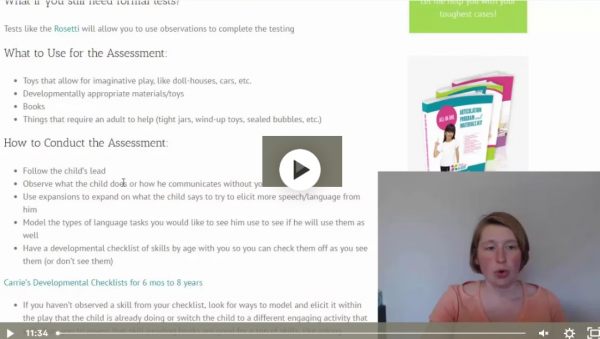Below are the links to the products that were talked about in the Speechie show:
If you’d rather listen to the audio version of the Speechie Show, click here:
Or if you prefer to read the transcript, see below:
Welcome to the Speechie Show! Being a speech-language pathologist often means having too much work and not enough planning time. To beat the overwhelm, we’re bringing you the tricks and tools that will make your job a little bit easier.
Carrie: Hello everybody and welcome to the Speechie Show. I am your host Carrie Clark from speechandlanguagekids.com and I am here today with Leia Knight with languagefortheplayground.com. How are you Leia?
Leia: Hi I’m good thanks.
Carrie: Good, so glad to have you on today. We are talking about language samples. So, if you are having trouble getting some excellent language samples, Leia is here to share with us five tips for collecting those language samples and getting some really good ideas of what kind of language skills these children have. So, while we are waiting for everybody to hop on the Facebook Live, if you are on with us now go ahead and type in where you’re watching from. I’d love to know where everybody is today. Alright so if you’re new to the show, my name is Carrie Clark and I run speechandlanguagekids.com and the Speechie Show. We do this every week, every Monday afternoon. We have had a few weeks off as we had some illness and some cancellations. So, we are here today and we are back on track and we are talking to Leia. Why don’t you go ahead and give us an introduction about yourself, Leia?
Leia: Okay. So, my name is Leia Knight and I am a deaf educator specialized in listening and spoken language. So, language is my favorite and I work in a preschool with children for special needs.
Carrie: Fantastic. And you have a website over at languagefortheplayground.com, right?
Leia: Yes
Carrie: And tell us what you have going on over there.
Leia: So first I labeled it, or called it Language for the Playground because I really like doing the approach of like social skills and language and how it’s going to apply in real life. So, on the playground what are you going to do? So, it’s all about language and social skills.
Carrie: Fantastic! So, if you’re looking for some help with your social skills and your language students head on over there to languagefortheplayground.com. Alright, we’re going to jump in now with our five tips for language samples. So, the first we’re going to talk about today is using picture books. Leia, talk to us about how you use picture books and your language samples.
Leia: So first I love to give kids a reason to talk and I feel like picture books are awesome for that because especially if they can’t read yet then they have a reason to be talking about it. And so, I like to use wordless picture books because there’s a lot going on in the pictures to talk about and I also like to use an app, it’s called the Imagistory. It’s like a wordless picture book from an app and it recorded their voice. So, I like to use those because it gives them a reason to talk and you can just like let him fly and see where they go with it.
Carrie: Perfect. So that, if you missed that, that’s the Imagistory app and we will have that link in the show notes. I also I love using books for language samples, too. And I actually had a friend of mine do her master’s thesis on what kinds of books elicited the most language. So, when did the kids start talking the most. And I thought it was really fascinating. What she found was when she used non-fiction books with pictures, of course with the smaller children, that got the most language. And I think that it was those real pictures; you know it’s pictures about dinosaurs or airplanes and there’s a lot to talk about in those non-fiction books as opposed to some of the character books. Like the Dora books or the Elmo books where everything’s kind of already put together and laid out and there’s not really much more to talk about or explore. So, I just thought that was kind of a fun study. That if you use non-fiction books you’re expanding their literary repertoire, but you’re also getting better language samples. Alright, so the next step we are going to talk about then is using an expectant look. So, Leia, tell us what this looks like in your language samples.
Leia: So the expectant look is the look that says “what, tell me more”. hahaha Sorry! So, this is going to be like the silliest thing ever. So, the preschool person that I am. So, I give an expectant look like it’s your WOW OH WHAT! Just like be super excited. Another expectant look is like “oh that doesn’t make sense” like…hahaha. And kids just feel compelled to respond when you look really silly like that. I like to use that one. And it just happens on the fly, however your look comes out at the moment.
Carrie: Yeah, I also like to pair this one with a very expectant pause. Because the longer you just wait in silence the more like the child feels like okay well now I got to say something because she looks crazy and she’s just standing there. Hahaha. So, absolutely pair that expectant look with an expectant pause. What? And then just kind of wait. Sometimes you have to wait a little longer than you even feel comfortable doing, but it definitely helps. Alright, so we’ve talked about using picture books and we’ve talked about the expectant look. So, the next thing we’re going to talk about is using some open-ended…click here to read the full transcript.

About the Author: Carrie Clark, MA CCC-SLP
Hi, I’m Carrie! I’m a speech-language pathologist from Columbia, Missouri, USA. I’ve worked with children and teenagers of all ages in schools, preschools, and even my own private practice. I love digging through the research on speech and language topics and breaking it down into step-by-step plans for my followers. I graduated from Truman State University in Kirksville, MO with a masters degree in Communication Disorders.
Connect with Me:










HI Carrie,
Can you give the spelling for the “Imagistory” app? I can’t find it in the Playstore for Androids but maybe I am spelling it wrong?..
Thanks!
Hi, Veronica-
Here is the link for the Imagistory app.